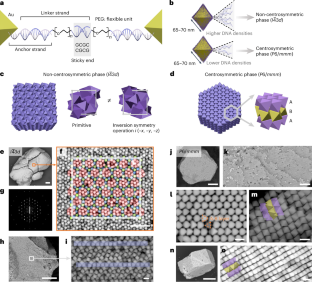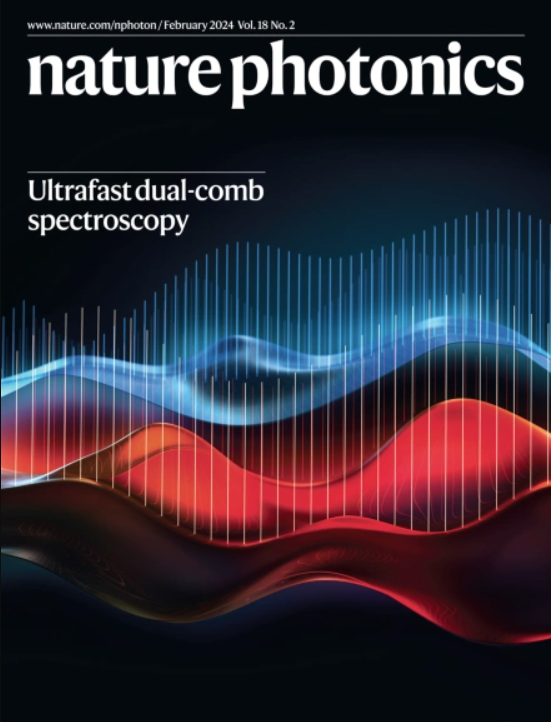非线性光学胶体元晶体
IF 32.9
1区 物理与天体物理
Q1 OPTICS
引用次数: 0
摘要
天然晶体中的原子和分子结构反转对称性破坏决定了它们的物理特性,包括非线性光学(NLO)效应、压电性或铁电性以及非互易电荷传输行为。对于由纳米级构件(即元原子)组成的超材料,平面上的空间反转对称性违反会导致自旋控制光子学和 NLO 超表面。低对称性三维元晶体可以合成,但至今尚未发现 NLO 行为(例如谐波发生)。在此,我们展示了如何利用 DNA 介导的八面体形质子金纳米晶体组装来设计和有意合成非中心对称和中心对称胶体晶体。重要的是,虽然中心对称结构不会产生大量二次谐波,但非中心对称晶体却能产生二次谐波--这是等离子热点局部电场分布不对称的结果。此外,这种非中心对称 NLO 超晶体代表了一种通过自下而上方法开发的三维 NLO 超材料,其最大二次谐波发生转换效率为 10-9,超过了在大多数等离子体二维超表面中观察到的效率。最后,粒子构件上的 DNA 负载密度可用于在中心对称和非中心对称相之间切换。本文章由计算机程序翻译,如有差异,请以英文原文为准。


Nonlinear optical colloidal metacrystals
Atomic and molecular structure inversion symmetry breaking in naturally occurring crystals dictate their physical properties including nonlinear optical (NLO) effects, piezo- or ferroelectricity, and non-reciprocal charge transport behaviour. With metamaterials composed of nanoscale building blocks (that is, meta-atoms), the spatial inversion symmetry violation on planar surfaces leads to spin-controlled photonics as well as NLO metasurfaces. Synthetically, low-symmetry 3D metacrystals can be synthesized, but NLO behaviour has not been identified so far (for example, harmonic generations). Herein we show how DNA-mediated assembly of octahedron-shaped plasmonic gold nanocrystals can be used to design and deliberately synthesize non-centrosymmetric and centrosymmetric colloidal crystals. Importantly, while the centrosymmetric structures do not exhibit substantial second-harmonic generation, the non-centrosymmetric crystals do—a consequence of the asymmetric distribution of localized electric fields in plasmonic hotspots. Moreover, this non-centrosymmetric NLO metacrystal represents a 3D NLO metamaterial being developed via a bottom-up approach, exhibiting a maximum second-harmonic generation conversion efficiency of 10−9 to surpass the efficiencies observed in the majority of plasmonic 2D metasurfaces. Finally, the DNA-loading density on the particle building blocks can be used to toggle between the centrosymmetric and non-centrosymmetric phases. Researchers use a DNA-mediated approach for the programmable assembly of octahedron-shaped plasmonic gold nanocrystals into nonlinear optical metacrystals. A maximum second-harmonic generation conversion efficiency of 10−9 is demonstrated.
求助全文
通过发布文献求助,成功后即可免费获取论文全文。
去求助
来源期刊

Nature Photonics
物理-光学
CiteScore
54.20
自引率
1.70%
发文量
158
审稿时长
12 months
期刊介绍:
Nature Photonics is a monthly journal dedicated to the scientific study and application of light, known as Photonics. It publishes top-quality, peer-reviewed research across all areas of light generation, manipulation, and detection.
The journal encompasses research into the fundamental properties of light and its interactions with matter, as well as the latest developments in optoelectronic devices and emerging photonics applications. Topics covered include lasers, LEDs, imaging, detectors, optoelectronic devices, quantum optics, biophotonics, optical data storage, spectroscopy, fiber optics, solar energy, displays, terahertz technology, nonlinear optics, plasmonics, nanophotonics, and X-rays.
In addition to research papers and review articles summarizing scientific findings in optoelectronics, Nature Photonics also features News and Views pieces and research highlights. It uniquely includes articles on the business aspects of the industry, such as technology commercialization and market analysis, offering a comprehensive perspective on the field.
 求助内容:
求助内容: 应助结果提醒方式:
应助结果提醒方式:


